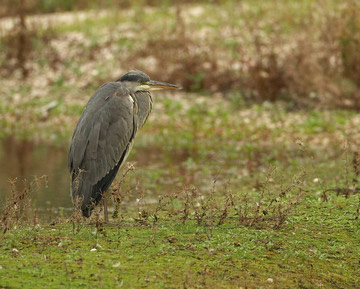
Grey Heron © Richard Steel
This is a bird with two distinct characters: when breeding, they form large groups, nesting colonially at the tops of tall trees; in winter, they are solitary birds in flat, open areas. This is emphasised by the records submitted: of 529 counts of Grey Herons, half of them were of single birds. There were only 23 counts in double-figures, most of them of birds back at their breeding sites after the New Year, with just a few gatherings at daytime loafing or roosting areas: some birds spend much of their day in a sheltered spot, often alone but sometimes in small groups, by far the largest of which was 47 birds at Inner Marsh Farm.
In a lot of places, especially on linear watercourses and ponds, a Grey Heron can be seen regularly and detailed studies have shown that many birds return repeatedly to specific feeding sites, with the better ones defended against other herons. In winter Grey Herons continue with their diet of any aquatic food but most larger fishes move to deeper waters as the temperature drops so herons broaden their intake to include a wider range of prey, with, famously, Water Rails on the Dee saltmarshes, and on occasion rabbits, rats, squirrels and Water Voles, but they show their opportunistic nature by also spending time catching worms in flooded fields. The numbers on the Mersey estuary built up rapidly as water quality improved and more fish were present: from single figures in the 1970s, WeBS counts built up to 53 in 1990/91.
The map shows Grey Herons to be widespread in winter, present in 486 tetrads. They were recorded flying over another 30 tetrads, not mapped. They were found in a wide range of habitats. Estuarine and saltmarsh codes were submitted from 42 tetrads, with 367 freshwater records. Their distribution suggests a preference for the county’s smaller waters, either standing or flowing: 77 pond; 74 small water-body; 68 lake/ unlined reservoir; 4 lined reservoir; 14 sand pit, etc; 44 stream; 38 river; 19 ditch; 14 small canal; and 15 large canal. There were 103 records of farmland habitat codes, mostly grassland: the versatility of herons is such that they will exploit almost any damp area. In winter, many Grey Herons utilise built-up areas although, surprisingly, there were only 35 records from human habitats; they are wary birds, often visiting in the semi-darkness and leaving at the first sign of disturbance, so are probably under-recorded.
Most British birds are said to be resident (BTO Winter Atlas), but the median distance of juvenile dispersal is around 50 km and three birds ringed as chicks in Cheshire colonies have been reported from overseas in their first winter. One from the Oakmere heronry in 1990 was reported on 4 February 1991 in Iceland, the only British-ringed bird to be found in that country where herons are rare migrants. Another from the Runcorn area heronries was shot in Denmark on 24 November 1990, only the second British-ringed Grey Heron there, and a third was in county Louth in Ireland in December 1973. The wintering population is boosted by an unknown number of immigrants, mostly from Scandinavia, where Grey Herons have to leave to find unfrozen feeding areas (Migration Atlas). In hard weather in Britain, some herons concentrate in coastal areas but many stay on inland freshwater, often moving to flowing waters; if sub-zero temperatures persist for more than a few days, many Grey Herons, especially immature birds, die, and winter weather is the main factor affecting their population. During this Atlas period the winter of 2005/ 06, not particularly severe but with more frost-days than any year since the mid-1990s, had a noticeable effect on breeding totals, most Cheshire and Wirral heronries seeing a drop of around 10% in the numbers of nests.
Sponsored by Macclesfield RSPB Members Group

